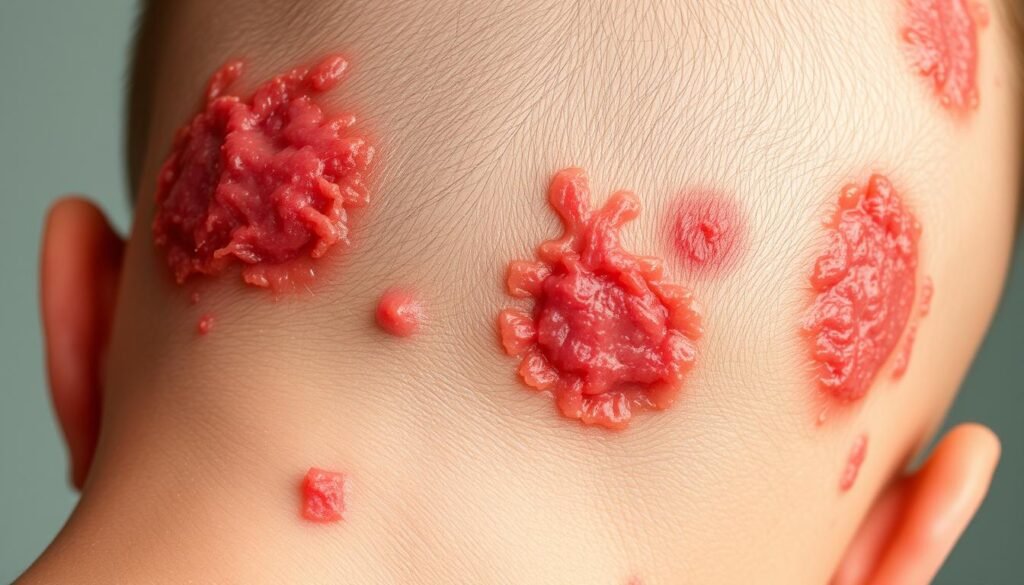Did you know seborrheic dermatitis impacts 1% to 3% of people everywhere? This fact shines a light on how common this inflammatory skin condition really is. It is known for causing an itchy scalp, dandruff, and red skin. It often shows up as a skin rash in oily areas of the body.
This skin issue is seen a lot in folks with oily skin, like those who get dandruff. Things like stress, changes in weather, and hormone shifts can make it worse. Although it’s not catchy, it can really affect your daily life. Spotting symptoms early is key. These include oily skin and scales, which look different on everyone. Treatments often use medicated shampoos, antifungal creams, and sometimes steroids.
We aim to offer deep insights on seborrheic dermatitis symptoms, reasons it happens, risks, and treatment. This helps those dealing with it to find comfort and manage the condition well.
Key Takeaways
- Seborrheic dermatitis affects 1% to 3% of the general population, with higher prevalence in immunocompromised individuals.
- Common symptoms include an itchy scalp, dandruff, and red, oily patches on the skin.
- The condition is typically more severe in cold, dry climates and during periods of stress.
- Topical antifungal agents are a first-line therapy for managing seborrheic dermatitis effectively.
- Recognizing symptoms early aids in the effective management of this often chronic skin condition.
What is Seborrheic Dermatitis?
Seborrheic dermatitis is a long-lasting skin issue, often called seborrheic eczema. It shows up as a skin rash with red, swollen areas and greasy flakes. This typically occurs in places with lots of oil glands like the scalp, face, and upper back. While often starting in babies as cradle cap, it can continue into adulthood, especially in those with oily skin.
In adults, it causes scaly patches on the scalp and face, making for a troublesome look. It’s most common in adults between 30 and 60 years old, and more so in men. Those with acne or immune issues are at higher risk. The good news is, the condition doesn’t directly lead to serious problems like hair loss. Rather, hair loss can happen from scratching or rubbing the areas.
Knowing about seborrheic dermatitis is key to handling it well. There are many treatments out there, ranging from over-the-counter to prescribed options. Learning about what is seborrheic dermatitis can help people get the right treatment and manage symptoms better.
Understanding Seborrheic Dermatitis Symptoms
Seborrheic dermatitis shows itself in different ways, depending on one’s age, skin, and where they live. Key symptoms are a flaky scalp, ongoing dandruff, and an itchy head. These issues can be bothersome and annoying. In worse situations, you might see red areas on the skin. These can have oily yellow or white flakes, especially on the scalp, face, or beard.
Common Symptoms Experienced
The main signs of seborrheic dermatitis are:
- Flaky scalp leading to visible dandruff
- Itchy scalp that might make irritation worse
- Oily yellow or white scales, often seen together
- Red skin patches that are uncomfortable
- In babies, a condition called cradle cap, with thick, red patches and oily dandruff
How Symptoms Vary by Age
Seborrheic dermatitis affects people of all ages differently. For babies, it often shows up as cradle cap but usually goes away within the first year. For teens and adults, from 30 to 60 years old, it’s more like dandruff. It brings an itchy head and red skin areas. It’s interesting to note that after 60, these issues might pop up less. Yet, those with oily skin or hair might still have them.
Causes of Seborrheic Dermatitis
Seborrheic dermatitis is an inflammatory skin condition with unclear origins. Its causes could be many, such as an overgrowth of Malassezia yeast. This yeast is normally found on the skin. But when it grows too much, it leads to the symptoms of the condition.
Too much oil on the skin can also lead to this fungal infection. Hormonal changes, especially during stress, can make it worse. Things like genes and weather changes can also cause problems for those at risk.
Seborrheic dermatitis shows up differently at various life stages. Infants get cradle cap, and adults get dandruff. It usually starts in the teen years and is common in those over 50. About 3% to 12% of people have symptoms of this long-term condition.
Studies show men get seborrheic dermatitis more than women. Stress, not eating right, and brain-related issues matter too. These factors show how complicated the causes of seborrheic dermatitis are. They can affect how bad and often the flare-ups are.
To manage this condition, you might need creams or to change your lifestyle. For more tips on dealing with seborrheic dermatitis, check out these resources.
Risk Factors and Who is Affected?
Seborrheic dermatitis affects certain groups, with babies and adults aged 30 to 60 most at risk. Men get it more due to links with hormones like androgens. Knowing who gets seborrheic dermatitis helps us understand and manage it better.
Demographics Most Commonly Affected
Babies, especially those under three months, often get seborrheic dermatitis. For adults, it’s more common in middle age. This shows the need for treatments aimed at these ages. Risk factors include:
- Gender: Males are diagnosed more often than females.
- Age: Infants and adults aged 30 to 60 years are most affected.
- Medical Conditions: Those with existing health issues face higher risks.
Pre-existing Conditions That Increase Risk
Certain health problems make seborrheic dermatitis more likely. They are:
- Parkinson’s disease
- HIV/AIDS
- Mental health conditions, such as depression
Oily skin, the environment, and how we live can also play roles. Stress, bad eating habits, and some meds raise the risk. Cold, dry weather and not enough sleep can make it worse.
Understanding the risk factors and affected groups helps in spotting symptoms and planning treatments. Keeping an eye on mental and physical health is key. This is because mental health issues can make the condition flare up.
| Demographic Group | Age Range | Risk Factors |
|---|---|---|
| Infants | Under 3 months | Genetic predisposition |
| Adults | 30-60 years | Mental health conditions, oily skin |
| Elderly | Over 60 years | Weakened immune system |
Identifying Seborrheic Dermatitis
Finding out if someone has seborrheic dermatitis starts with clear steps. Doctors usually spot this skin problem by just looking. They check for red skin, scales, and flakes. Sometimes, a skin test gives more info. Knowing how to pinpoint this condition is key to treat it well.
Common Diagnostic Steps
The steps to identify seborrheic dermatitis include:
- Medical History Review: Doctors look into the patient’s past health and skin issues.
- Physical Examination: They carefully check the skin for scales and swelling.
- Symptom Assessment: They talk about the itchiness and redness, and how long symptoms last.
- Exclusion of Other Conditions: Doctors rule out other skin problems to make sure the diagnosis is right.
Distinguishing from Other Skin Conditions
Figuring out skin issues needs careful thought. Seborrheic dermatitis is sometimes mixed up with psoriasis and eczema. However, certain features help tell them apart:
| Condition | Symptoms | Common Locations | Appearance |
|---|---|---|---|
| Seborrheic Dermatitis | Redness, scaling, flaking | Scalp, face, chest | Greasy patches, yellowish scales |
| Psoriasis | Thick, silvery scales | Elbows, knees, lower back | Well-defined, dry plaques |
| Eczema | Itchy, inflamed skin | Flexural areas, neck | Dry, cracked, red patches |
By focusing on these steps and knowing how different skin conditions look, health experts can make the right call on seborrheic dermatitis. Getting the diagnosis right means patients get the care that fits their needs.
Areas Most Commonly Affected
Seborrheic dermatitis mainly targets skin areas with many oil glands. It often hits the scalp, face, upper back, and chest. People usually notice oily skin that leads to greasy, scaly patches.
Scalp flaking is common, causing annoying flakes. Infants often get this condition, known as cradle cap, on their scalp. It usually gets better by 12 months.
In adults, it mostly starts between 30 and 60 years, affecting similar areas. Other body parts that can have problems include:
- Armpits
- Groin
- Facial areas, like the eyebrows and around the nose
The discomfort can vary from mild to severe. In some cases, it may even lead to temporary hair loss. Knowing these affected areas helps in finding the right treatments, like special shampoos or creams.

| Commonly Affected Areas | Characteristics |
|---|---|
| Scalp | Visible flakes and redness |
| Face | Oily patches, scales, and irritation |
| Upper Back | Greasy, scaly reactions |
| Chest | Potential for redness and discomfort |
| Armpits | Scaly areas and odor |
| Groin | Itchy, inflamed patches |
Understanding which areas are prone to seborrheic dermatitis helps us identify symptoms and explore treatment options.
Treatment Options for Seborrheic Dermatitis
Seborrheic dermatitis can be managed well with the right treatments. There are over-the-counter and prescription options available. These treatments aim to ease symptoms and prevent flare-ups. Finding the most suitable treatment can greatly improve your life.
Over-the-Counter Products
Many people start with over-the-counter products to fight seborrheic dermatitis. These products might include:
- Zinc pyrithione – This ingredient fights yeast on the scalp with its antifungal power.
- Selenium sulfide – It’s used in shampoos to target dandruff and improve scalp health.
- Ketoconazole – An effective antifungal that can treat seborrheic dermatitis.
These available solutions can help control mild symptoms. They provide relief when used regularly.
Prescription Treatment Options
When over-the-counter treatments aren’t enough, doctors may suggest prescription options. Some options include:
- Topical antifungal medications – Like ciclopirox and hydrocortisone, they reduce inflammation.
- Calcineurin inhibitors – These drugs, including tacrolimus and pimecrolimus, are effective with less risk than corticosteroids.
- Oral antifungal medications – For severe cases, medications such as itraconazole or terbinafine might be used.
These options address the inflammation and irritation caused by seborrheic dermatitis. Regular meetings with your doctor will help you find the best treatment plan. Being proactive about your symptoms and treatment can improve your management of the condition over time.
Managing Symptoms and Flare-Ups
To manage seborrheic dermatitis well, you need a good plan. This includes regular skin care and changes in your lifestyle. Caring for your skin every day helps a lot. It can reduce flare-ups and ease symptoms. Using simple methods can make your skin healthier and boost your overall happiness.
Importance of Skincare Routine
A good skincare routine is key in controlling seborrheic dermatitis. It should involve:
- Regular cleansing with gentle cleansers to remove excess oil and debris.
- Moisturizing daily to prevent dryness and irritation.
- Using topical treatments that have ingredients like hydrocortisone or antifungal agents, ideally recommended by a healthcare professional.
Keeping up with your skincare routine not only controls your symptoms. It also helps you feel more confident about yourself if you have this condition.
Lifestyle Changes and Stress Management
Changing your lifestyle can also help with seborrheic dermatitis. Stress can make it worse, so it’s important to find ways to relax. Some good ways to lower stress include:
- Yoga: It helps your body and mind relax.
- Meditation: It keeps your mind calm and can lower stress.
- Outdoor activities: Being outside can boost your mood and lessen anxiety.
By focusing on both your skincare and managing stress, you can create a full plan. This plan can help you manage seborrheic dermatitis better and live a happier life.

| Practice | Description | Benefits |
|---|---|---|
| Gentle Cleansing | Using mild cleansers daily | Reduces oil and irritation |
| Moisturizing | Applying moisturizers regularly | Prevents skin dryness |
| Stress Relief Techniques | Yoga, meditation, outdoor activities | Promotes mental well-being |
Understanding the Psychological Impact
Seborrheic dermatitis impacts more than just physical health. It also has psychological effects. People feel anxious, embarrassed, and might have low self-esteem. This comes from the visible symptoms of the skin condition.
There’s a social stigma around skin conditions that affects mental well-being. So, it’s key to see the emotional side of seborrheic dermatitis.
Stress can make the symptoms worse, leading to a cycle where stress and skin issues feed off each other. About 82% say stress triggers their symptoms. This shows how managing stress is critical.
The link between stress and seborrheic dermatitis needs more study. One research (exploring stress and seborrheic dermatitis) shows patients with higher anxiety.
Young people and women often feel more upset by their condition. Parents of babies with cradle cap also feel worried. This highlights the effect on caregivers too.
Many find help online or with groups like the National Eczema Association. Good treatment routines can ease symptoms. But, it’s a challenge to keep them up.
Avoiding certain products helps manage the condition. Stress-reduction and support can greatly help those affected.
Dealing with both the psychological effects and physical symptoms of seborrheic dermatitis is key. This leads to a better life for those with this common skin issue.
When to Seek Medical Advice
Seborrheic dermatitis can be tricky to handle, so knowing when to get help is key. If symptoms stay or get worse even after taking care of yourself, see a doctor. Also, if there’s more pain or the rash changes a lot, you might need medical care.
Signs That Require Professional Intervention
It helps to know certain signs that mean you should see a doctor. Here are the main ones:
- Persistent Flaking: If flaking or scaling keeps up, you should get it checked out.
- Intense Itching: Really bad itching that stops you from doing daily things means you might need help.
- Signs of Infection: More redness, swelling, or pus points to a possible infection.
- Worsening Condition: If things get worse despite using store-bought treatments, it’s time to see a doctor.
- New Areas of Flare-Ups: Seborrheic dermatitis showing up in new places is a sign to seek advice.

Long-term Management Considerations
Managing seborrheic dermatitis long-term means regular doctor visits to keep an eye on symptoms. Making a plan that suits you is important for keeping it under control. This plan might include:
- Regular Dermatological Consultations: Seeing your doctor often helps adjust treatment and watch for symptom changes.
- Education on Triggers: Knowing what sets off your symptoms can help you manage better.
- Consistency in Treatment: Sticking to your treatment, like special shampoos, can help a lot.
- Lifestyle Adjustments: Learning how to manage stress might lower the number of bad skin days.
Being informed and alert to certain signs helps people deal with seborrheic dermatitis better. This way, they can lead happier lives.
Conclusion
Learning about seborrheic dermatitis is key to handling this skin issue. It’s a common condition that causes red, scaly, itchy patches. These appear mainly in oily areas of the body. Adults and infants both can get it. By spotting symptoms early and knowing what triggers it, people can better manage their discomfort.
Treating this condition includes using special shampoos. Ingredients like ketoconazole or ciclopirox are in these products. It’s also smart to talk with healthcare providers. They can help customize a treatment plan. Being informed about seborrheic dermatitis helps people care for themselves better.
Even though dealing with seborrheic dermatitis can be tough, there’s hope. Getting the right care makes a big difference. Talking openly with doctors helps. It makes it easier to understand and fight this condition. This leads to better health and happiness.